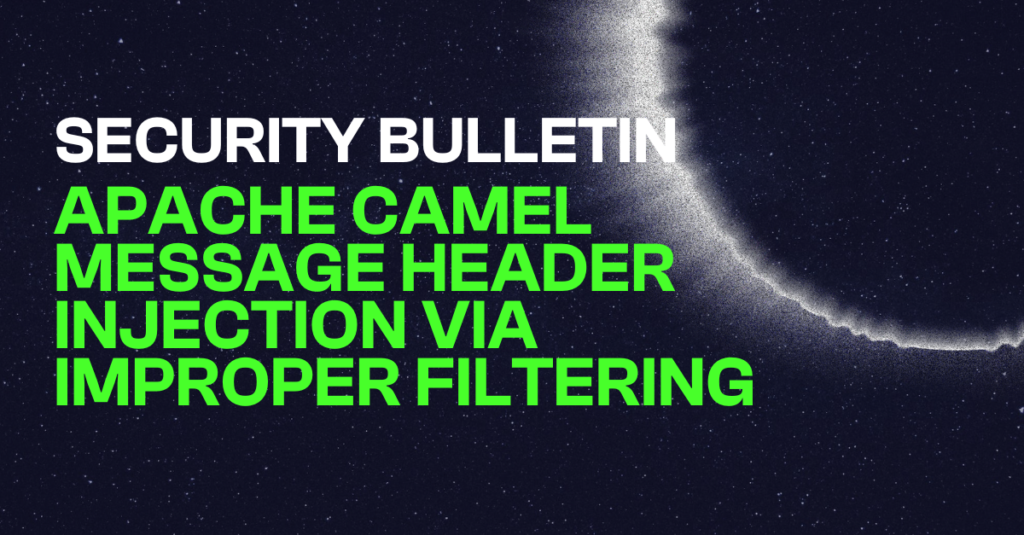In the days leading up to the publication of the Apache Camel Message Header Injection via Improper Filtering, now known as CVE-2025-27636, alarmist noise emerged from the wider cyber community, with Kevin Beaumont describing it as an “end of the world zero day” in Apache Camel, along with explicit details on how elements of this vulnerability worked. Apache have since disclosed that the vulnerability is only present in very specific conditions of the Apache Camel-Bean component where improper input validation in these specific circumstances could enable a threat actor to craft Camel header names and to alter the behaviors of the Camel Bean component.
Vulnerability Type (CWE)
CWE-1321: Improper Handling of Case Sensitivity (Input Filtering)
The product does not properly account for differences in case sensitivity when accessing or determining the properties of a resource, leading to inconsistent results.
CVSS Score (at the time of writing)
Base Score: In flux – however, a moderate 5.1 temporary score has been assigned by VulnDB
Attack Vector: Network (AV:N) – Exploitable remotely via HTTP requests containing crafted headers. An attacker can target any exposed Camel endpoint (e.g. a web service) without physical access.
Attack Complexity: High (AC:H) – Successful exploitation requires a specific application configuration and knowledge of internal method names. The target service must be using Camel’s HTTP-based components and routing to a backend bean with multiple methods . This non-default scenario.
Privileges Required: None (PR:N) – No prior authentication is needed. If a Camel application is exposed to the internet (e.g. a public HTTP endpoint), an attacker can send malicious requests directly without credentials
User Interaction: None (UI:N) – The attack is initiated by the attacker’s crafted input alone; no user involvement is required once a vulnerable service is accessible.
Scope: Medium (S:U) – The injected headers affect the Camel application’s own execution context. The attack does not inherently escape to other systems or elevate privileges beyond the targeted service’s scope.
Impact on Confidentiality/Integrity/Availability: (C:L/I:L/A:L) The confidentiality impact is Low. The integrity impact is low. The availability impact is low.
Impacted Versions
| Branch | Affected Versions | Recommended Upgrade |
|---|---|---|
| 4.10.x LTS | 4.10.0 – 4.10.1 | 4.10.2 |
| 4.8.x LTS | 4.8.0 – 4.8.4 | 4.8.5 |
| 3.x | 3.10.0 – 3.22.3 | 3.22.4 |
Mitigation Steps
Users are recommended to upgrade to version 4.10.2 and by removing the headers in your Camel routes via the use of the removeHeaders EIP with the pattern “.removeHeaders(“”, “Camel”, “camel*”, “org.apache[.]camel.*”)” to filter out all headers except those beginning with “Camel”, “camel”, or “org.apache.camel.”, which will effectively exclude any improperly cased variations such as “cAmel” or “cAMEL” while preserving only the correctly formatted Camel headers. (Apache’s Jira)
Exploit Process
The affected Apache Camel instances 4.10.0 to 4.10.1, from 4.8.0 to 4.8.4 and from 3.10.0 to 3.22.3 are vulnerable due to a bug in the default security filter, designed to prevent unauthorized header injections, to be case-sensitive. All the known Camel HTTP components such as:
camel-servlet
camel-jetty
camel-undertow
camel-platform-http
camel-netty-http would be vulnerable out of the box. In terms of usage of the default header filter strategy the list of components using that is:
camel-activemq
camel-activemq6
camel-amqp
camel-aws2-sqs
camel-azure-servicebus
camel-cxf-rest
camel-cxf-soap
camel-http
camel-jetty
camel-jms
camel-kafka
camel-knative
camel-mail
camel-nats
camel-netty-http
camel-platform-http
camel-rest
camel-servlet
camel-sjms
camel-spring-rabbitmq
camel-stomp
camel-tahu
camel-undertow
camel-xmppWhich when combined with the Camel-Bean component, would allow the threat actor to circumvent this filter by crafting requests to change the capitalization of the header names. Successful exploitation would enable the injection of arbitrary headers to trigger unintended method calls within the application’s Bean registration by using Simple Expression Language or Object-Graph Navigation Language (OGNL) into method parameters or in the case of camel-jms, redirect messages to unintended queues. This is particularly concerning for Camel applications directly exposed to internet traffic via HTTP however it is constrained to methods within the bean defined in the route’s URI.
Timeline
2025-03-04 – Assigned CVE-2025-27636 (link)
2025-03-09 – NVD Published Date (link)
TTPs & IOCs
- Monitor for anomalous or oddly capitalized HTTP requests used to bypass this filter.
- Monitor for headers crafted to invoked unintended methods within the targeted Camel bean which will use Simple Expression Language or OGNL to manipulate the method parameters.
- In camel-jms instances, the attackers will manipulate headers to redirect messages to unauthorized queues on the same broker.
- Monitor for the targeting of internet-facing Camel applications that use the vulnerable HTTP components.
Centripetal’s Perspective
As Apache Camel is extensively used in enterprise environments across multiple industries as a powerful open-source integration framework that allows developers to integrate various systems and applications. This makes it highly valuable for businesses that need to connect disparate software and a high value target.
Although this CVE has been assigned as a moderate criticality, it is recommended that users of Apache Camel assess their deployment and apply remediations and mitigations as advised.
Users with the CleanINTERNET® service in front of any of their assets will continue to receive the protections provided by emerging threat intelligence related to threat actors who may attempt to exploit this vulnerability. If you are a current client of Apache Camel and wish to discuss this further, please contact support@centripetal.ai.
Centripetal is also pleased to offer Penetration Testing and Vulnerability Assessment services to help organizations identify vulnerabilities and reduce risk. If interested, please contact our Professional Services team at profservs@centripetal.ai or reach out to your Centripetal Account Representative.
Resources
- https://doublepulsar.com/no-there-isnt-a-world-ending-apache-camel-vulnerability-edd055f40d39
- https://lists.apache.org/thread/l3zcg3vts88bmc7w8172wkgw610y693z
- https://issues.apache.org/jira/browse/CAMEL-21838
- https://www.cve.org/CVERecord?id=CVE-2025-27636
- https://camel.apache.org/security/CVE-2025-27636.html
- https://vuldb.com/?id.299054
- https://nvd.nist.gov/vuln/detail/CVE-2025-27636#VulnChangeHistorySection
- https://debricked.com/vulnerability-database/vulnerability/CVE-2025-27636
- https://cve.mitre.org/cgi-bin/cvename.cgi?name=CVE-2025-27636
- https://camel.apache.org/security/CVE-2025-27636.txt.asc
- https://www.openwall.com/lists/oss-security/2025/03/09/1
- https://my.f5.com/s/article/K000150304
